2000 HONDA PASSPORT tow
[x] Cancel search: towPage 204 of 267

R — Replace L — Lube I — Inspect After inspection, clean, adjust, repair or replace if necessary.
Check oi
l and coolant level at each fuel stop.
Under severe driving conditions, service these items more often. These conditions are: Service for severe driving conditions
Repeated short trips in cold weather Frequent idling and/or frequent low-speed operation Change engine oil and filter - Every 3,750 miles (6,000 km) Driving in dusty areas Towing a trailer or 3 months
Change rear axle oil - Every 15,000 miles (24,000 km)
Care an d Maintenanc e
Page 209 of 267
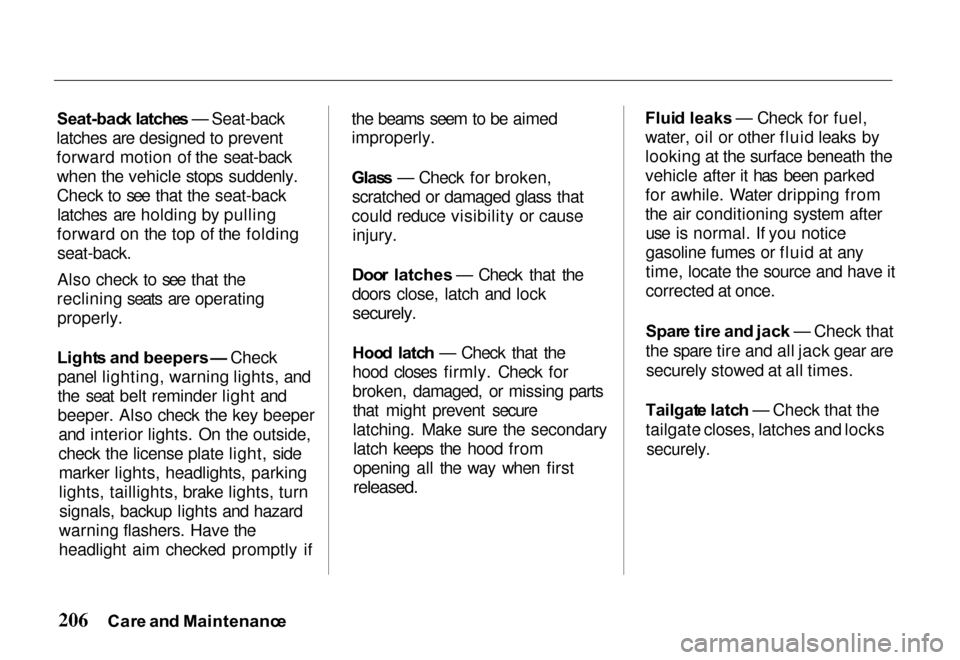
Seat-bac
k latche s — Seat-back
latches are designed to prevent
forward motion of the seat-back when the vehicle stops suddenly.
Check to see that the seat-backlatches are holding by pulling
forward on the top of the folding
seat-back.
Also check to see that the
reclining seats are operating properly.
Light s an d beepers — Check
panel lighting, warning lights, and
the seat belt reminder light and
beeper. Also check the key beeper and interior lights. On the outside,
check the license plate light, sidemarker lights, headlights, parking
lights, taillights, brake lights, turnsignals, backup lights and hazard
warning flashers. Have the
headlight aim checked promptly if the beams seem to be aimed
improperly.
Glas
s — Check for broken,
scratched or damaged glass that
could reduce visibility or cause injury.
Doo r latches — Check that the
doors close, latch and lock
securely.
Hoo d latc h — Check that the
hood closes firmly. Check for
broken, damaged, or missing parts that might prevent secure
latching. Make sure the secondarylatch keeps the hood from
opening all the way when first
released.
Flui
d leaks — Check for fuel,
water, oil or other fluid leaks by
looking at the surface beneath the
vehicle after it has been parked
for awhile. Water dripping from
the air conditioning system after use is normal. If you notice
gasoline fumes or fluid at any
time, locate the source and have it
corrected at once.
Spar e tir e an d jac k — Check that
the spare tire and all jack gear are securely stowed at all times.
Tailgat e latc h — Check that the
tailgate closes, latches and locks
securely.
Car e an d Maintenanc e
Page 211 of 267

Change the oil and oil filter every
3,750 miles (6,000 kilometers) or
every three months if you drive under one or more of these
"severe driving" conditions: Driving in dusty areas
Towing a trailer
Frequent idling or idling for
long periods Frequent short trips (4 miles [6
kilometers] or less) in cold or
freezing weather, where the
engine does not thoroughly
warm up. Change the oil and oil filter as
soon as possible after driving in
a dust storm.
Oi
l Chang e
Changing the oil and filter requires
special tools and access from underneath the vehicle. The vehicle
should be raised on a service station-type hydraulic lift for this
service. Unless you have the
knowledge and proper equipment,
you should have this maintenance
done by a skilled mechanic.
1. Warm up the engine. This makes the oil drain faster and
more thoroughly.
2. Remove the oil filler cap.
3. Remove the drain plug and drain oil fully.
4. Install the drain plug, with a new gasket, and tighten it.
5. Fill the engine with the proper amount of new oil (see
"Specifications"). Oil Filter Installation
1. Remove the old oil filter with the filter wrench.
2. Apply a light coat of engine oil to the oil filter gasket.
3. Hand-tighten the filter until the gasket contacts the sealing
face.
4. Using the filter wrench, tighten the filter one full turn.
5. Run the engine and inspect for
leaks.
6. Shut off the engine. After a couple of minutes, check the
oil level. If necessary, add oilto bring it to the FULL mark.
An improperly installed oil filter can result in severe engine
damage.
Car e an d Maintenanc e
NOTIC
E
Page 226 of 267
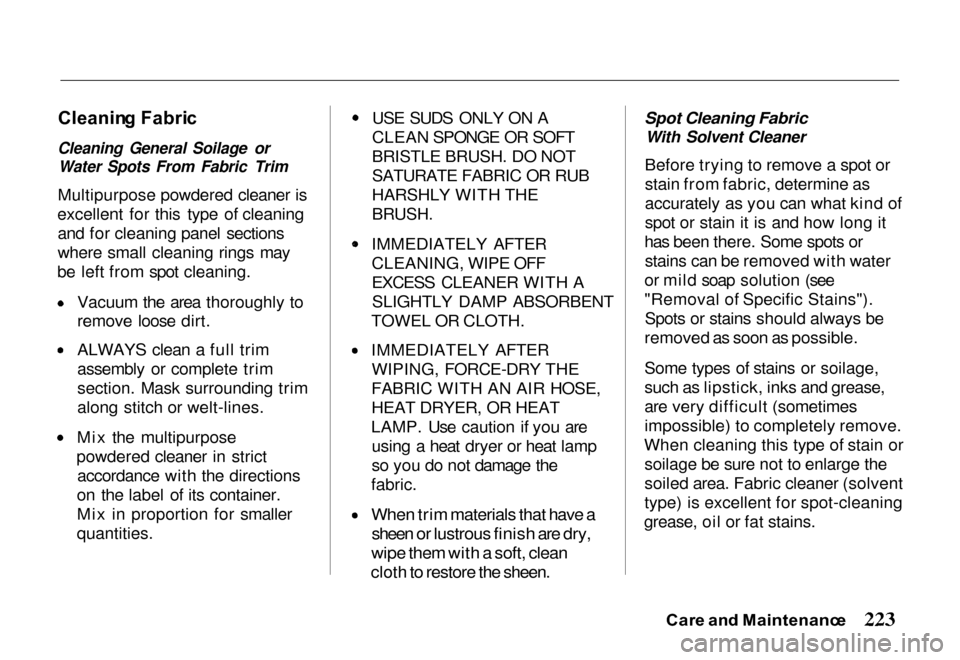
Cleanin
g Fabri c
Cleaning General Soilage or
Water Spots From Fabric Trim
Multipurpose powdered cleaner is
excellent for this type of cleaning and for cleaning panel sections
where small cleaning rings may
be left from spot cleaning. Vacuum the area thoroughly to
remove loose dirt.
ALWAYS clean a full trim
assembly or complete trim
section. Mask surrounding trim
along stitch or welt-lines.
Mix the multipurpose
powdered cleaner in strict accordance with the directions
on the label of its container.
Mix in proportion for smaller
quantities. USE SUDS ONLY ON A
CLEAN SPONGE OR SOFT
BRISTLE BRUSH. DO NOT
SATURATE FABRIC OR RUB
HARSHLY WITH THE
BRUSH.
IMMEDIATELY AFTER
CLEANING, WIPE OFF
EXCESS CLEANER WITH A
SLIGHTLY DAMP ABSORBENT
TOWEL OR CLOTH. IMMEDIATELY AFTER
WIPING, FORCE-DRY THE
FABRIC WITH AN AIR HOSE, HEAT DRYER, OR HEAT
LAMP. Use caution if you are using a heat dryer or heat lamp
so you do not damage the
fabric.
When trim materials that have a
sheen or lustrous finish are dry,
wipe them with a soft, clean
cloth to restore the sheen.
Spot Cleaning Fabric
With Solvent Cleaner
Before trying to remove a spot or
stain from fabric, determine as
accurately as you can what kind of
spot or stain it is and how long it
has been there. Some spots or stains can be removed with water
or mild soap solution (see
"Removal of Specific Stains"). Spots or stains should always be
removed as soon as possible.
Some types of stains or soilage,
such as lipstick, inks and grease,
are very difficult (sometimes
impossible) to completely remove.
When cleaning this type of stain or soilage be sure not to enlarge the
soiled area. Fabric cleaner (solvent
type) is excellent for spot-cleaning
grease, oil or fat stains.
Car e an d Maintenanc e
Page 227 of 267
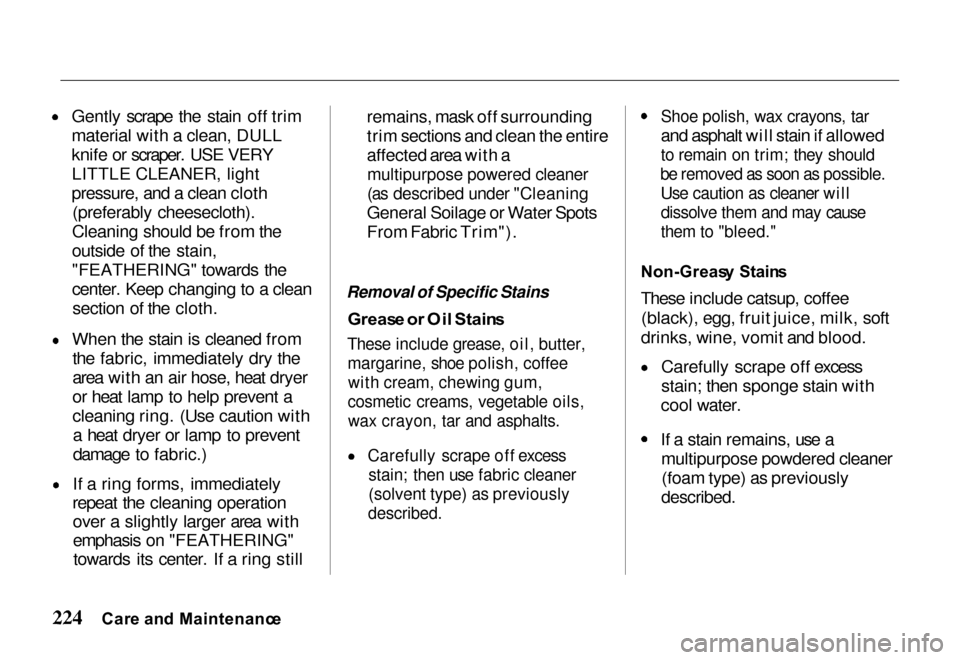
Gently scrape the stain off trim
material with a clean, DULL
knife or scraper. USE VERY
LITTLE CLEANER, light
pressure, and a clean cloth
(preferably cheesecloth).
Cleaning should be from the
outside of the stain,
"FEATHERING" towards the
center. Keep changing to a clean section of the cloth. When the stain is cleaned from
the fabric, immediately dry the
area with an air hose, heat dryer
or heat lamp to help prevent a
cleaning ring. (Use caution witha heat dryer or lamp to prevent
damage to fabric.) If a ring forms, immediately
repeat the cleaning operation over a slightly larger area with
emphasis on "FEATHERING"towards its center. If a ring still remains, mask off surrounding
trim sections and clean the entire
affected area with a
multipurpose powered cleaner
(as described under "Cleaning
General Soilage or Water Spots
From Fabric Trim").
Removal of Specific Stains
Greas e o r Oi l Stain s
These include grease, oil, butter,
margarine, shoe polish, coffee
with cream, chewing gum,
cosmetic creams, vegetable oils,
wax crayon, tar and asphalts.
Carefully scrape off excess
stain; then use fabric cleaner
(solvent type) as previously
described.
Shoe polish, wax crayons, tar
and asphalt will stain if allowed
to remain on trim; they should
be removed as soon as possible.
Use caution as cleaner will
dissolve them and may cause
them to "bleed."
Non-Greas y Stain s
These include catsup, coffee (black), egg, fruit juice, milk, soft
drinks, wine, vomit and blood. Carefully scrape off excess
stain; then sponge stain with
cool water. If a stain remains, use a
multipurpose powdered cleaner(foam type) as previously
described.
Car e an d Maintenanc e
Page 229 of 267
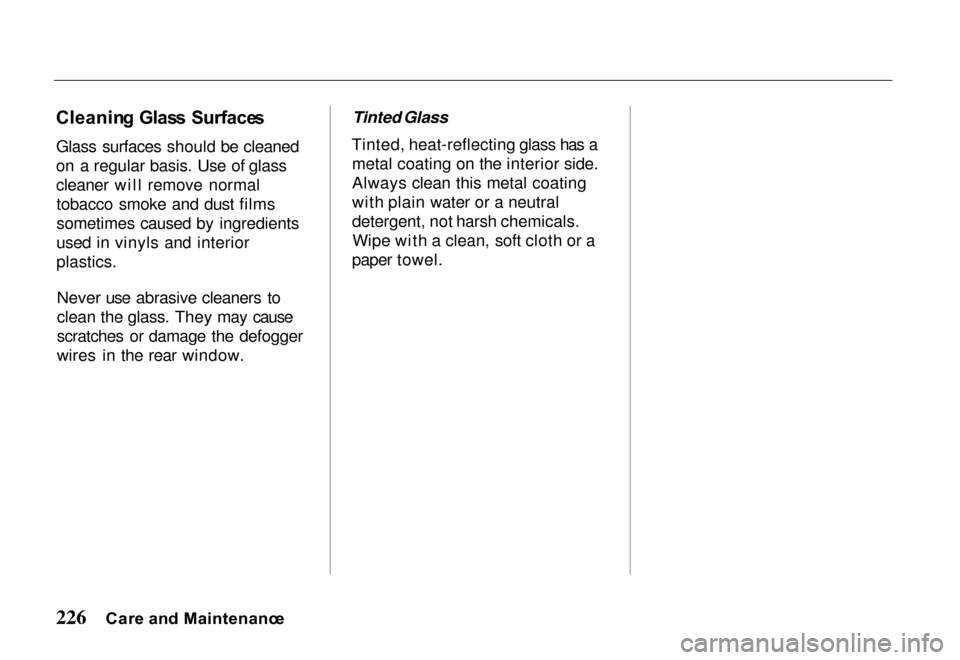
Cleanin
g Glas s Surface s
Glass surfaces should be cleaned
on a regular basis. Use of glass
cleaner will remove normal tobacco smoke and dust films
sometimes caused by ingredients
used in vinyls and interior
plastics.
Never use abrasive cleaners to
clean the glass. They may cause
scratches or damage the defogger
wires in the rear window.
Care an d Maintenanc e
Tinted Glass
Tinted, heat-reflecting glass has a metal coating on the interior side.
Always clean this metal coating
with plain water or a neutral
detergent, not harsh chemicals.Wipe with a clean, soft cloth or a
paper towel.
Page 247 of 267
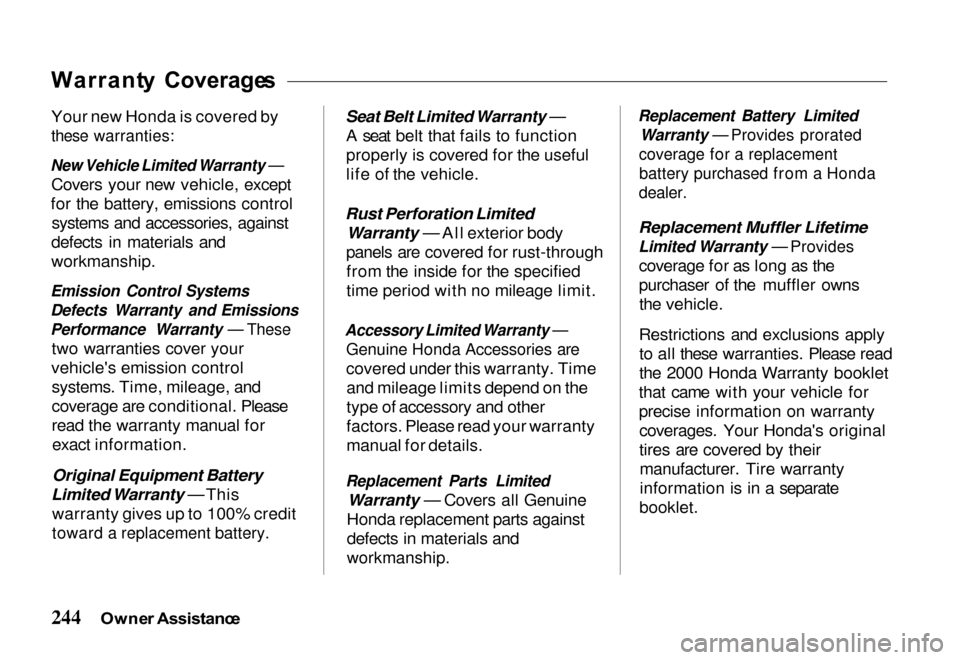
Warrant
y Coverage s
Your new Honda is covered by
these warranties:
New Vehicle Limited Warranty —
Covers your new vehicle, except
for the battery, emissions control systems and accessories, against
defects in materials and
workmanship.
Emission Control Systems
Defects Warranty and Emissions
Performance Warranty — These
two warranties cover your
vehicle's emission control systems. Time, mileage, and
coverage are conditional. Please
read the warranty manual forexact information.
Original Equipment Battery
Limited Warranty — This warranty gives up to 100% credit
toward a replacement battery.
Seat Belt Limited Warranty —
A seat belt that fails to function
properly is covered for the useful
life of the vehicle.
Rust Perforation Limited Warranty — All exterior body
panels are covered for rust-through from the inside for the specified
time period with no mileage limit.
Accessory Limited Warranty —
Genuine Honda Accessories are
covered under this warranty. Timeand mileage limits depend on the
type of accessory and other
factors. Please read your warranty
manual for details.
Replacement Parts Limited
Warranty — Covers all Genuine
Honda replacement parts against
defects in materials and
workmanship.
Replacement Battery Limited
Warranty — Provides prorated
coverage for a replacement
battery purchased from a Honda
dealer.
Replacement Muffler Lifetime
Limited Warranty — Provides
coverage for as long as the
purchaser of the muffler ownsthe vehicle.
Restrictions and exclusions apply to all these warranties. Please read
the 2000 Honda Warranty booklet
that came with your vehicle for
precise information on warranty coverages. Your Honda's original
tires are covered by theirmanufacturer. Tire warranty
information is in a separate
booklet.
Owne r Assistanc e
Page 257 of 267

Coolant
Adding ................ 214
Capacity ............... 232
Checking ............. 213
Proper Solution ......... 214
Temperature Gauge ....... 58
Corrosion Protection ....... 221 Courtesy Lights ........... 108
Crankcase Emission Control System .......... 246
Cruise Control Operation .... 143
Customer Relations Information ............. 242
DANGER, Explanation of .... iv Dashboard ................ 54
Dead Battery, What to Do ... 180 Defects, Reporting Safety .. . 245
Defogger, Rear Window ..... 72
Defrosting the Windows .... 118
DEXRON III
AutomaticTransmission Fluid ...... 212
Digital Clock ............... 149
Dimensions .............. 239
Dimming the Headlights .... 70
Dipstick, Engine Oil ... 196, 209
Directional Signals .......... 73
Disabled, Towing Your Vehicle If .... 187
Disc Brake Wear Indicators . . 158
Dome Light .............. 107
Door Locks ............... 9 Power ................ 100 Doors, Close and Lock ....... 10
DOT Tire Quality Grading ... 247
Downshifting, 5-Speed
Manual Transmission ....... 82
Drive Belts ............... 218
Driving, On-Road Fuel Economy .......... 166In Bad Weather ......... 164
In Foreign Countries ..... 169
On Slippery Surfaces ..... 158
Economy, Fuel ............ 166 EGR System .............. 247
Emergency Brake ........... 84
Emergency Flashers ......... 74